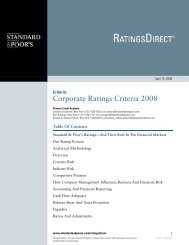European Infrastructure Finance Yearbook - Investing In Bonds ...
European Infrastructure Finance Yearbook - Investing In Bonds ...
European Infrastructure Finance Yearbook - Investing In Bonds ...
You also want an ePaper? Increase the reach of your titles
YUMPU automatically turns print PDFs into web optimized ePapers that Google loves.
UTILITIES<br />
16 ■ NOVEMBER 2007<br />
transmission grids in England and Wales (as well<br />
as some U.S. network assets). While Centrica has<br />
a higher level of business risk than National Grid<br />
because its earnings are competitively exposed<br />
and are more volatile, this is compensated by<br />
Centrica’s significantly lower leverage. Following<br />
National Grid’s recent acquisition of U.S.-based<br />
KeySpan Corp. (A-/Stable/A-2), unadjusted net<br />
debt will increase to approximately £19.5 billion<br />
by 2009, from £11.8 billion in 2007, with<br />
consolidated funds from operations (FFO) interest<br />
coverage of about 3.5x and FFO to total debt of<br />
about 15%. By comparison, in the 12 months to<br />
June 2007, Centrica’s FFO coverage of adjusted<br />
net debt was very strong at about 97%.<br />
Why would an ISO model have less of an impact<br />
on credit quality than unbundling?<br />
An ISO model in which the operational<br />
management and investment plans of transmission<br />
networks would be controlled and determined by<br />
parties independent of the owners has been<br />
presented as an alternative--and potentially less<br />
politically divisive--option than ownership<br />
unbundling. The impact of such a move on the<br />
ratings in the sector would in principle be<br />
significantly less than that of unbundling, because<br />
the network owners would not be forced to divest<br />
and would retain access to the relatively solid,<br />
stable, and predictable network earnings<br />
(compared with, for example, volatile power<br />
generation earnings).<br />
An ISO model would mean that the vertically<br />
integrated utilities--such as E.ON, RWE, EDF,<br />
EnBW, and Vattenfall--that own transmission<br />
networks and whose credit quality benefits from<br />
such ownership, would continue to own the<br />
network and consolidate their earnings. Rating<br />
risk under an ISO model would, therefore, be<br />
limited compared with the significant rating risk<br />
presented by ownership unbundling.<br />
The ultimate effect of such a move would<br />
depend, however, on factors such as whether the<br />
networks would continue to be fully consolidated.<br />
<strong>In</strong> addition, current transmission network owners<br />
could decide to unilaterally sell networks if an<br />
ISO system were introduced, thereby redeploying<br />
capital from what would be a passive low-risk<br />
investment into a fully controlled and managed<br />
investment such as high-risk power generation.<br />
STANDARD & POOR’S EUROPEAN INFRASTRUCTURE FINANCE YEARBOOK<br />
What was the impact on Scottish Power and<br />
Scottish and Southern Energy when the operation<br />
of their transmission networks moved to an<br />
ISO model?<br />
None. National Grid has operated the<br />
transmission networks of Scottish Power and<br />
Scottish and Southern Energy since 2005.<br />
Both companies continue to consolidate their<br />
transmission networks, and their consolidated<br />
credit quality continues to benefit from the<br />
relatively stable earnings of the<br />
transmission networks. ■



